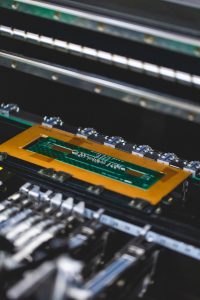Calculating the Maximum Bending Radius For Flexrigid PCBs
Maximum Bending Radius For Flexrigid PCBs
When designing a flex-rigid PCB, it’s important to take into consideration the mechanical properties of the board. This is especially important for ensuring the copper circuitry can withstand bending forces without causing damage to the traces and components. A common problem is broken copper traces, which occurs when the board is bent or twisted, resulting in cracking and breaking of the conductors. It can also cause other issues like short circuits and signal degradation.
To prevent this from happening, it is critical to use a large enough bending radius for flexrigid PCBs. This is accomplished by using a minimum ten times the thickness of the board thickness for the flex circuit, as this will limit the number of times the PCB can be bent. This will also help ensure the traces remain intact when the board is in its retracted position.
In order to calculate the proper bending radius for a flex-rigid PCB, designers must consider several factors including:
One factor that influences the maximum bend radius is the type of material used for the board. This is because different materials have differing flexibility characteristics, which will affect how easily the board can be bent. For this reason, it is essential to select the right material for your application when designing a flex-rigid.

Calculating the Maximum Bending Radius For Flexrigid PCBs
Another important factor to consider is the type of plating used on the traces in a flex-rigid PCB. This is because different types of copper have different flexibilities, which will influence how easily the traces can be bent. Generally speaking, it is best to use rolled annealed copper, as this will allow for a greater degree of flexibility in the PCB.
The number of layers on a flex-rigid PCB can also impact the maximum bending radius. This is because more layers will make the PCB stiffer, which will require a larger bending radius to avoid damage to the copper circuitry. Ideally, the flex-rigid PCB should have a low number of layers to minimize the stiffening effect.
Other important factors that influence the maximum bending radius for a flex-rigid are the number of plated holes and vias on the design. It is best to keep plated holes and vias away from the flexible section, as this will reduce the likelihood of them being damaged during bending. Additionally, plated holes should be sized with at least a 10 mil annular ring around them to better protect them during bending.
The most important thing to remember when designing a flex-rigid is that the minimum bending radius requirements are in place for a reason. Without them, your flex-rigid design could exceed the physical capabilities of the copper circuitry and create problems that would be very difficult to resolve. For this reason, it is vital to follow strict DFM guidelines for flex-rigid PCBs when creating your design, and always consult with your CM’s engineering team for the best advice and assistance. Keeping these DFM guidelines in mind will help you create a high-quality, reliable flex-rigid PCB that can perform well under any conditions.